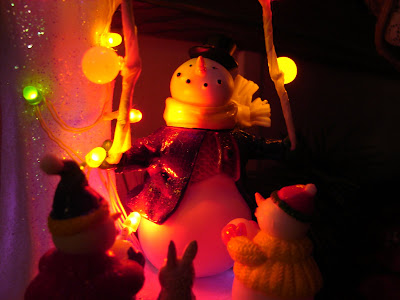Miz Cassie-B says, "I'm really big on cropping when I get a good shot. It makes it so much easier for me when I know I can cut out the parts that don't matter. "
And Moma Grits had this to say, "My own personal preference is to FILL THE FRAME and be mindful of the background ya don't want a light pole emerging from your subjects head."
Now, for my daily tip.
LIGHTING
Lighting is probably the most important aspect of ALL photography. Choose a scene outside your window and watch what happens to it during different times of the day. Watch the shadows, the way the scene does or doesn't get sunlight, the type and mood of the sunlight that it does get, etc,,, The lighting greatly affects how your scene will photograph.
The best times of day for landscape, architecture or outdoor portraits is always either early morning or early evening. The rising or setting sun creates a warmth not seen during other times of the day.
The best angle for outdoor shots is with the sun directly behind you. This allows the sunlight to fall on your scene, or subject, and also allows you to be able to control the shadows. One little trick I picked up from reading my photo mags and from visiting a forum or two, is when you keep getting shadows on the faces of your subjects, especially when the sun is high, or in a deep shade, turn on your flash so that it will fill in the shadowed areas with light.
Not having enough light will cause your photos to look too dark, or too grainy, sometimes even blurry. Of course using the flash helps, but sometimes it makes the photo look too washed out if you are too close to your subject when the flash goes off. One way that helps me when I'm taking indoor shots and don't want to use a flash (for example, a lighted Christmas tree) is to set my camera on a small, table top tripod and take the photo like that, trying not to move or shake the camera when I focus and click. A standing tripod would be even better, but I don't have a large standing tripod yet, that's on my Wish list. The less or worse the lighting, the more important it becomes to not move or shake your camera when you're taking the photo.
 I took this photo on auto focus, hand held, with only the glow from the tree lights. If you enlarge it, you can see the graininess and quite a bit of blurring.
I took this photo on auto focus, hand held, with only the glow from the tree lights. If you enlarge it, you can see the graininess and quite a bit of blurring.Photography is fun, and what's been the most fun for me is that you don't have to have the most expensive equipment to get great results. For the past several years, I've been using a Sony DSC H1 , 5.1 mega pixel digital with a 12x zoom, and I recently bought a Sony DSC H50/B, 9.1 megapixel, with a 15x zoom. I think they're both great cameras and I've gotten some pretty nice photos while using them, well, the H1, I haven't had much time to really try out the H50/B yet. I'm not ready for all the extra equipment that it takes for an SLR right now, maybe some day.

Awareness of lighting and composition are the cornerstones of good photography. It was so much tougher in the old days with film cameras and manual settings, LOL! Today's equipment makes is much easier and simpler for great results.
ReplyDeleteA Tripod!!! I need one of those, Badly!! My shots will blurr...light the Christmas tree shots! Thanks Brenda...going shopping!hughugs
ReplyDeleteHi Brenda,
ReplyDeleteGreat idea for a blog. I personally need all the help I can get with learning how to take a good photo so I'll be by to visit alot. Also great tips. Thanks!
Oh I forgot to tell you that I have a little Sony that fits in my purse(it's at the camera hospital right now) and I just got a Nikon Coolpix P80 with a great zoom like your Sony's. I have gotten some good photos with both of them.
ReplyDelete